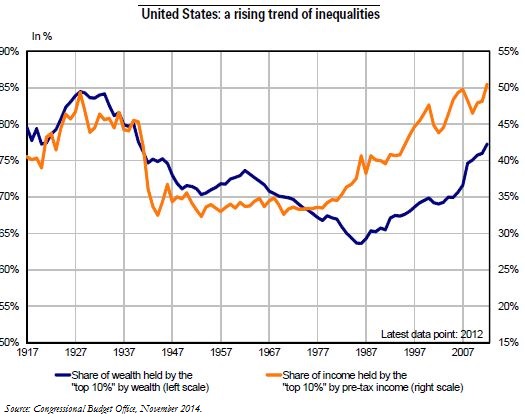Trésor-Economics No. 147 - Inequalities, poverty and social mobility in the United States: a major economic and social issue
Income and wealth inequalities in the U.S. have risen since the late 1970s, with only a temporary interruption by the 2007-2009 recession. At the same time, after being cut in half from the late 1950s to the beginning of the 2000s, the absolute poverty rate has increased significantly, and has now returned to the level of the mid-1960s. Finally, in sharp contrast to the traditional view of the American dream, social mobility in the U.S. has been among the lowest in the OECD countries for decades.
Many explanations of the trend in inequalities, poverty and social mobility have been advanced, but not all represent a consensus view. Three main explanatory factors can be identified: (i) the gradual transformation of the labour market partly fuelled by technological development, which has led to growing polarisation between high-skilled, well-paid jobs and low-skilled, low-wage jobs; (ii) the inability of the educational system to fully play its role in promoting upward mobility and meet the private sector's growing need for skilled labour; and (iii) the limited redistributive effect of the current tax and social transfer system, which does little to correct income inequalities.
While the impact of inequalities on economic growth continues to be debated, a growing number of studies show that inequality is a drag on growth. In particular, widening inequality constrains human capital accumulation by reducing the educational opportunities of a growing number of disadvantaged people. In addition, because poorer households have a greater propensity to consume than wealthier households, the rise in income inequalities restrain consumption expenditure in the long run. Greater inequalities had only a limited impact on the U.S. economy so far; the negative effects seem to have been masked in the 2000s by a strong increase in household debt. Tighter credit standards for lending to households since the onset of the crisis in 2007 should limit the risk of returning to unsustainable debt levels. The continued rise in inequalities could then begin to constrain growth, unless wages for the lowest-paid workers are raised, either by statutory hikes in state or federal minimum wages, or by individual companies.
To counter the effects of increased poverty and inequalities, economists and international organisations recommend broad structural reforms, such as improved training for the unemployed or the reduction of tax breaks for the wealthy. Still, while American economists on the whole are concerned about the high level of poverty and low social mobility, they are more divided regarding inequalities.
